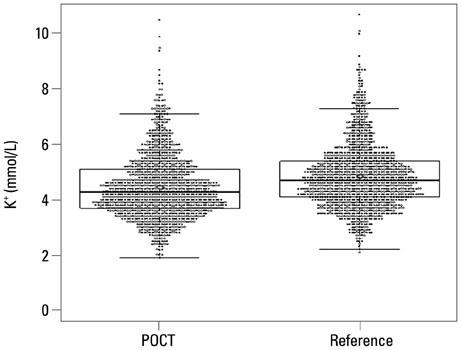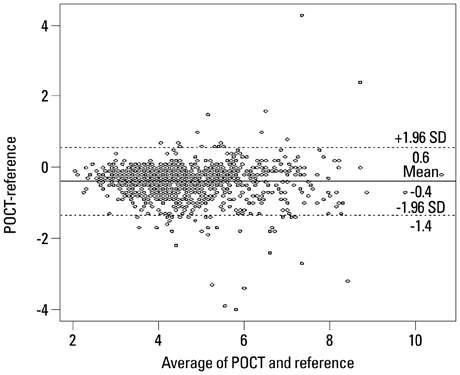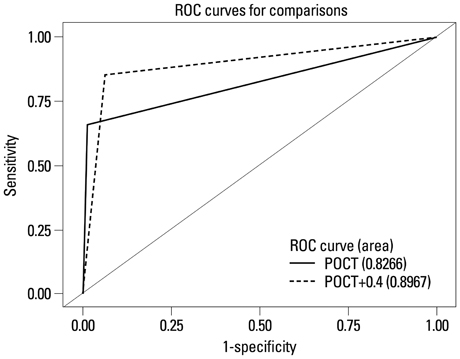Yonsei Med J.
2014 Sep;55(5):1348-1353. 10.3349/ymj.2014.55.5.1348.
Evaluating the Utility of Rapid Point-of-Care Potassium Testing for the Early Identification of Hyperkalemia in Patients with Chronic Kidney Disease in the Emergency Department
- Affiliations
-
- 1Department of Emergency Medicine, Yonsei University College of Medicine, Seoul, Korea. emstar@yuhs.ac
- 2Department of Emergency Medicine, Graduate School of Medicine, Kangwon National University, Chuncheon, Korea.
- 3Department of Research Affairs, Biostatistics Collaboration Unit, Yonsei University College of Medicine, Seoul, Korea.
- 4Department of Emergency Medicine, Changwon Fatima Hospital, Changwon, Korea.
- 5Department of Emergency Medicine, National Health Insurance Corporation Ilsan Hospital, Goyang, Korea.
- KMID: 1799501
- DOI: http://doi.org/10.3349/ymj.2014.55.5.1348
Abstract
- PURPOSE
Severe hyperkalemia leads to significant morbidity and mortality if it is not immediately recognized and treated. The concentration of potassium (K+) in the serum increases along with deteriorating renal function. The use of point-of-care K+ (POC-K+) in chronic kidney disease (CKD) could reduce the time for an accurate diagnosis and treatment, saving lives. We hypothesized that POC-K+ would accurately report K+ serum level without significant differences compared to reference testing, regardless of the renal function of the patient.
MATERIALS AND METHODS
The retrospective study was performed between January 2008 and September 2011 at an urban hospital in Seoul. The screening program using POC was conducted as a critical pathway for rapid evaluation and treatment of hyperkalemia since 2008. When a patient with CKD had at least one warning symptom or sign of hyperkalemia, both POC-K+ and routine laboratory tests were simultaneously ordered. The reliability of the two assays for serum-creatinine was assessed by intra-class correlation coefficient (ICC) analysis using absolute agreement of two-way mixed model.
RESULTS
High levels of reliability were found between POC and the laboratory reference tests for K+ (ICC=0.913, 95% CI 0.903-0.922) and between two tests for K+ according to changes in the serum-creatinine levels in CKD patients.
CONCLUSION
The results of POC-K+ correlate well with values obtained from reference laboratory tests and coincide with changes in serum-creatinine of patients with CKD.
MeSH Terms
Figure
Reference
-
1. Lehnhardt A, Kemper MJ. Pathogenesis, diagnosis and management of hyperkalemia. Pediatr Nephrol. 2011; 26:377–384.
Article2. Hsieh MF, Wu IW, Lee CC, Wang SY, Wu MS. Higher serum potassium level associated with late stage chronic kidney disease. Chang Gung Med J. 2011; 34:418–425.3. An JN, Lee JP, Jeon HJ, Kim DH, Oh YK, Kim YS, et al. Severe hyperkalemia requiring hospitalization: predictors of mortality. Crit Care. 2012; 16:R225.
Article4. Kwak JR, Gwon M, Lee JH, Park MS, Kim SH. Non-oliguric hyperkalemia in extremely low birth weight infants. Yonsei Med J. 2013; 54:696–701.
Article5. Tintinalli JE. Emergency Medicine: A Comprehensive Study Guide. 6th ed. New York: McGraw-Hill;2004. p. 173.6. Stein W, Hellmeyer L, Schmidt S, Tekesin I. Intraobserver and interobserver reliability of transvaginal cervical length measurements and quantitative ultrasound tissue characterization of the cervix in the second and third trimester of pregnancy. Ultraschall Med. 2011; 32:Suppl 2. E169–E174.
Article7. McGrew JH, Stull LG, Rollins AL, Salyers MP, Hicks LJ. A comparison of phone-based and on-site assessment of fidelity for assertive community treatment in Indiana. Psychiatr Serv. 2011; 62:670–674.
Article8. Desirable Specifications for Total Error, Imprecision, and Bias, derived from intra- and inter-individual biologic variation. accessed on 2013 July 15. Available at: http://www.westgard.com/biodatabase1.htm.9. Vos G, Engel M, Ramsay G, van Waardenburg D. Point-of-care blood analyzer during the interhospital transport of critically ill children. Eur J Emerg Med. 2006; 13:304–307.
Article10. José RJ, Preller J. Near-patient testing of potassium levels using arterial blood gas analysers: can we trust these results? Emerg Med J. 2008; 25:510–513.
Article11. Chhapola V, Kanwal SK, Sharma R, Kumar V. A comparative study on reliability of point of care sodium and potassium estimation in a pediatric intensive care unit. Indian J Pediatr. 2013; 80:731–735.
Article12. Jain A, Subhan I, Joshi M. Comparison of the point-of-care blood gas analyzer versus the laboratory auto-analyzer for the measurement of electrolytes. Int J Emerg Med. 2009; 2:117–120.
Article13. Bloom BM, Connor H, Benton S, Harris T. A comparison of measurements of sodium, potassium, haemoglobin and creatinine between an Emergency Department-based point-of-care machine and the hospital laboratory. Eur J Emerg Med. 2013; [Epub ahead of print].
Article
- Full Text Links
- Actions
-
Cited
- CITED
-
- Close
- Share
- Similar articles
-
- The Application of a Dried Balanced Heparin Syringe Can Attenuate the Dilution Effect in Rapid Point-of-care Potassium Testing for the Early Identification of Hyperkalemia in the Emergency Department
- Hyperkalemia in Chronic Kidney Disease
- Clinical Characteristics of Patients with Chronic Kidney Disease Associated with Marked Bradycardia
- Potassium Balances in Maintenance Hemodialysis
- Impaired aldosterone response to potassium and hyperkalemia in patients receiving a renin-angiotensin-aldosterone system inhibitor




